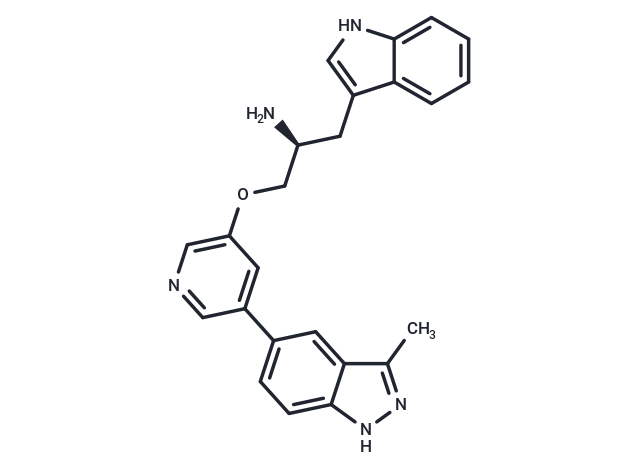Shopping Cart
Remove All Your shopping cart is currently empty
Your shopping cart is currently empty
A-443654, a pan-Akt inhibitor, exhibits equal potency against Akt1, Akt2, and Akt3 within cells (Ki=160 pM).

| Pack Size | Price | USA Warehouse | Global Warehouse | Quantity |
|---|---|---|---|---|
| 1 mg | $84 | In Stock | In Stock | |
| 5 mg | $198 | In Stock | In Stock | |
| 10 mg | $322 | In Stock | In Stock | |
| 25 mg | $597 | In Stock | In Stock | |
| 50 mg | $913 | In Stock | In Stock | |
| 100 mg | $1,370 | In Stock | In Stock | |
| 200 mg | $1,850 | In Stock | In Stock | |
| 500 mg | $2,730 | - | In Stock | |
| 1 mL x 10 mM (in DMSO) | $226 | In Stock | In Stock |
| Description | A-443654, a pan-Akt inhibitor, exhibits equal potency against Akt1, Akt2, and Akt3 within cells (Ki=160 pM). |
| Targets&IC50 | KDR:3.1 μM (Ki), Akt3:160 pM (Ki), PKA:6.3 nM (Ki), PKCγ:24 nM (Ki), RSK2:11 nM (Ki), GSK-3β:41 nM (Ki), Src:2.6 μM (Ki), MAPK-AP2:3.3 μM (Ki), c-Kit:1.2 μM (Ki), Akt2:160 pM (Ki), CK2:2.4 μM (Ki), ERK2:340 nM (Ki), Flt1:3.6 μM (Ki), CDK2:24 nM (Ki), PKCδ:33 nM (Ki), Akt1:160 pM (Ki), Chk1:2.3 μM (Ki) |
| In vitro | A-443654 demonstrates a significant improvement in potency with a K_i of 160 pM, a 30,000-fold increase compared to the initial lead molecule. It effectively reduces P-GSK3 in a dose-dependent manner across three cell lines and exhibits 40-fold greater selectivity for Akt over PKA, equally inhibiting Akt1, Akt2, and Akt3 within cells. Morphological changes induced by A-443654 are rapid, occurring within 2 to 4 hours in 10A and 10CA1a cells, with the latter being more sensitive. The compound hinders tumor cell proliferation, with an EC50 of 0.1 μM[1], and shows marked selectivity for mutant cells, inhibiting their growth more than 3.5 times compared to wild-type (WT) cells[3]. Furthermore, A-443654, especially when combined with rapamycin, significantly decreases Bcl-2 protein levels in 10A and 10CA1a cells, exhibiting a notable reduction in 10CA1a cells by approximately 70%. At 2 μM, A-443654 alone prompts 10CA1a cells to detach from the plate after 12 hours, illustrating a differential response compared to 10A cells, which remain unaffected at the same concentration[2]. |
| In vivo | A-443654, administered subcutaneously at a dosage of 7.5 mg/kg per day, effectively inhibits tumor growth in the 3T3-Akt1 flank tumor model. At a higher concentration of 30 mg/kg, this compound increases phosphorylated Akt1 levels in MiaPaCa-2 tumors. Furthermore, a dosage of 50 mg/kg induces apoptosis in 3T3-Akt1 flank tumors [1]. |
| Molecular Weight | 397.47 |
| Formula | C24H23N5O |
| Cas No. | 552325-16-3 |
| Smiles | C([C@@H](COC=1C=C(C=NC1)C=2C=C3C(=CC2)NN=C3C)N)C=4C=5C(NC4)=CC=CC5 |
| Relative Density. | 1.307 g/cm3 |
| Color | White |
| Appearance | Solid |
| Storage | Powder: -20°C for 3 years | In solvent: -80°C for 1 year | Shipping with blue ice/Shipping at ambient temperature. | |||||||||||||||||||||||||||||||||||
| Solubility Information | DMSO: 100 mg/mL (251.59 mM), Sonication is recommended. | |||||||||||||||||||||||||||||||||||
| In Vivo Formulation | 10% DMSO+40% PEG300+5% Tween 80+45% Saline: 4 mg/mL (10.06 mM), Sonication is recommended. Please add the solvents sequentially, clarifying the solution as much as possible before adding the next one. Dissolve by heating and/or sonication if necessary. Working solution is recommended to be prepared and used immediately. The formulation provided above is for reference purposes only. In vivo formulations may vary and should be modified based on specific experimental conditions. | |||||||||||||||||||||||||||||||||||
Solution Preparation Table | ||||||||||||||||||||||||||||||||||||
DMSO
| ||||||||||||||||||||||||||||||||||||
| Size | Quantity | Unit Price | Amount | Operation |
|---|

Copyright © 2015-2025 TargetMol Chemicals Inc. All Rights Reserved.